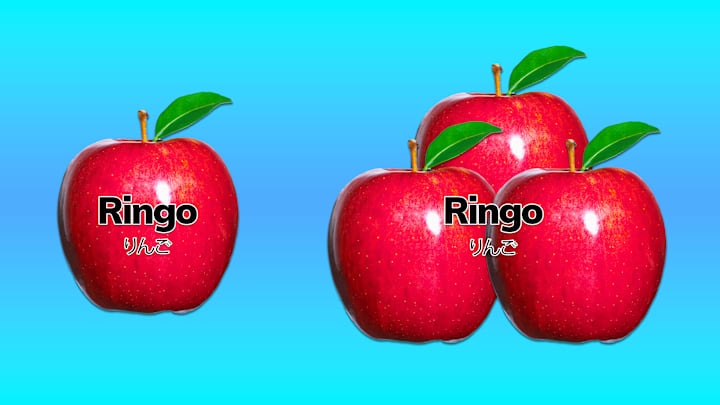You might think nouns are the most straightforward part of language. After all, they’re just words for people, places, and things, right? Think again. Across the world’s languages, nouns are surprisingly chameleonic creatures, shape-shifting and category-hopping in ways that can make your head spin. What’s countable in one language is an amorphous mass in another. What’s alive in one tongue is inanimate in its neighbor. It turns out that when it comes to nouns, what violated one language’s common sense is another’s charming quirk.
1. Quantifying Things (or Not)

Nouns have found many ways to mark number and quantity across different languages. In English, we simply add an s to most nouns to make them plural. Easy, right? Not so fast. In Japanese, as in many languages, nouns don’t typically change form for plural at all. Ringo (りんご) means both “apple” and “apples.” Context is king, and if you really need to specify, you can add a quantifier like many or provide a count.
But the quirks of quantity don’t stop there. A word that’s happy being plural in one language might demand to be dual—exactly two—in another. So, while English jumps from singular apple right to plural apples, some languages, such as Arabic, have an extra middle category: tuffaha ( تفاحة ), “apple,” tuffahatan (تفاحتان ), “two apples,” and tuffahat ( تفاحات ), “more than two apples.”
2. Count/Non-Count Conundrums

English speakers distinguish between count nouns and non-count ones: We count two chairs, for example, but two furnitures is ungrammatical. And this distinction can be so tricky that it even confuses native speakers. Take the word pea: In Middle English, it was the non-count noun, pease (think the rhyme “pease porridge hot, pease porridge cold …”). Only later did people start thinking of peas as little green individuals, backforming the singular pea, kind of like if someone were to create ja as the singular of jazz.
This fluidity isn’t only within English but also across languages. Around the linguasphere, the word police is often as countable as fingers on a hand. Spanish speakers can use cinco policías llegaron, “five police arrived,” without batting an eye, while German Polizisten and French policiers line up neatly for counting. American Sign Language users on Reddit also report counting cops with ease. But English? Instead of five police arrived, we either say “the police”—as if police were just a big blob of law enforcement—or we count the number of officers.
3. Classifier Chaos

Yet another way to deal with numbers in many languages is to use specialized classifiers—words that categorize nouns based on their shape, size, or other characteristics. English does this to some extent: we say “a sheet of paper” or “a loaf of bread.” But some languages take this to a whole nother level. In Mandarin Chinese, for instance, it’s as if every noun comes with its own special measuring cup. For example, shū (书), meaning “book,” is uncountable. Three books would be sān běn shū (三本书), literally “three volumes of book,” where běn is a countable classifier for bound objects like books and magazines. Want to count people? Use the classifier gè (个). Animals? That's zhī (只). Long, thin objects like rivers or snakes? You’ll need tiáo (条). But the chameleonic nature of these classifiers really shines in unexpected groupings. The classifier duǒ (朵) is used for flowers … and clouds. Zhāng (张) counts flat objects, like tickets and tables. There are dozens of these classifiers, and using the wrong one is like trying to measure water with a fork—it just doesn’t work.
4. Definite Differences

English uses words like the to mark nouns as definite—a specific something the listener should be able to identify—but other languages play this game differently, if at all.
Some languages find explicit definiteness markers a bit extravagant. In Russian, for instance, knigu (книгу) could mean “a book,” “the book,” or just “book.” Why specify when anyone can figure it out from context?
Others languages incorporate definiteness in unexpected ways. Icelandic marks it on the noun, like English does with plural -s or past-tense -ed: hestur, meaning “horse,” becomes hesturinn, “the horse.” Then there’s Greek, where even proper nouns typically need a definite article. Instead of Alexander left, it would be o Alexandros efyge (ο Αλέξανδρος έφυγε), literally “the Alexander left.” In the world of nouns, even definiteness is uncertain.
5. Animacy Antics

Many languages discriminate among nouns based on how “alive” or “person-like” they are. While English speakers might not think about it often, our language does this too. We use the person who … but the things which. We personalize ships and countries as she. But in some languages, animacy is much more thoroughgoing.
In Tłı̨chǫ Yatıì, a Dene language spoken in the Northwest Territories of Canada, for example, verbs often change form depending on the animacy of the subject. Five rocks fell uses a different verb form from five men fell, even though the action is the same.
But with nouns, everything, it seems, is capricious. In Algonquian languages like Ojibwe, nouns are divided into animate and inanimate categories. While humans and animals are predictably animate, so are some surprising entities like raspberries, kettles, and snowshoes. Meanwhile, strawberries are deemed inanimate and potatoes can go either way. These distinctions reflect problems with labels like “animate” and “inanimate,” which capture one aspect of the categories but miss others. In fact, the classification system is multidimensional. For instance, there’s a seasonal component, with one category encompassing both animate and winter-related items (like snowshoes), while the other includes inanimate and summer-related ones (like … chameleons?).
Discover More About Language:
